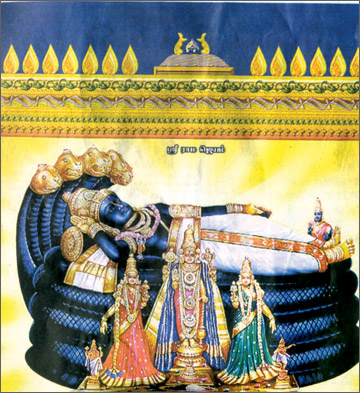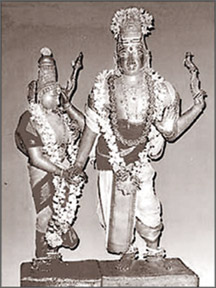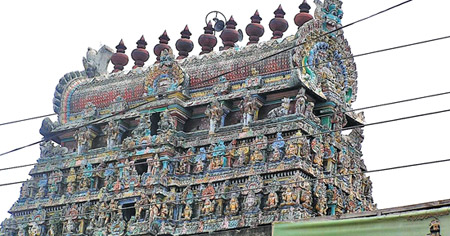|
HINDUISM
Dehiwela Nedumal Sri Venkadeswara :
Maha Vishnu’s Temple Maha Kumbabheshekam
Chelvatamby Maniccavasagar
Colombo, Dehiwala, Nedumal Sri Venkadeswara Maha Vishnu’s Maha
Kumbabheshekam (Consecration Ceremony) was held recently. Mr Ramaratna
Ratnarajah, Chief Trustee of the Temple made all the necessary
arrangements with the help of the devotees and the Temple’s Chief Priest
“VISHNU Pooja Thurantharar Bramasri”, Chandrakantha” performed all the
poojas and rituals to the greatest satisfaction of the devotees.
 Maha Vishnu is venerated by a large number of devotees as the
preserver of the universe. Lord Vishnu is one of the Thirumurthi Gods of
the Hindu Pantheon. In Sri Lanka He is specially revered as the
Custodian of the Island. Vaishnavites venerate him as the Supreme Deity.
The Vishnu Purana, a work of the 1st century (B.C) extols his
attributes. Maha Vishnu is venerated by a large number of devotees as the
preserver of the universe. Lord Vishnu is one of the Thirumurthi Gods of
the Hindu Pantheon. In Sri Lanka He is specially revered as the
Custodian of the Island. Vaishnavites venerate him as the Supreme Deity.
The Vishnu Purana, a work of the 1st century (B.C) extols his
attributes.
Mythology
Known in the early vedic times as a manifestation of Solar Energy, he
later became a deity of major importance and along with “Brahma” and
“Shiva” formed the Holy Thirumuthikal of Hinduism. All things emanate
from him say the Vaishnavites. In mythology, while Brahma performs
creations, Vishnu preserves the lives of all and sundry in the
universe.He is the embodiment of goodness and mercy. Because of his acts
of preservation and duration, he is a symbol of perpetual life and earns
the name “Narayana” meaning the “abode of man”.
Further, the sacred temple of Maha Vishnu at Nedimale, off Anderson
Road, Dehiwela has its beginning in the 18th century. A Vaishnavite
devotee supervisor who was engaged in the excavation of the Dutch Canal
near Dehiwela had a vision. He was told to seek a particular place for
his devotion to Lord Vishnu, his patron Deity. He gave up his search in
the jungle neighbouring Dehiwela after an initial attempt.
However, the vision occurred again, so he set forth with a
determination this time. Curiously, a young cow calf proceeded ahead of
him and stopped at a particular spot in the jungle. To his amazement,
the devotee found that it was a hallowed place. There were the ruins of
a well and all the signs of a one time Vaishnava Temple which had been
eclipsed. Tulasi plants, sacred to the Lord Vishnu flourished there.
Though there were several devotees of Lord Vishnu, looking after this
temple, a devotee of this Deity by the name “Ramaratnam” was indeed
responsible for making this temple popular by performing daily poojas
and annual festivals with the assistance and co-operation of the people
of the adjoining areas. In fact, this temple is a miraculous one and is
venerated by several Buddhists and Hindus in large numbers now. Besides,
several Lord Vishnu’s devotees and philanthropists have fabulously and
fantastically donated for numerous renovation, restoration and
re-construction works at this temple.
Special poojas
The daily poojas and annual festivals are conducted according to
Agamas and particularly and every Sunday special poojas are performed
and “Annathanam” is given to devotees who come to this temple in large
numbers from all parts of Colombo and even from Negombo and Chilaw
areas.
In fact, this Vishnu Temple has now become to be venerated as a
veritable “Thirupathy Shrine” in India.
The Vishnus consort is Maha Lakshmi and according to mythology she
arose from the milky ocean when it was churned by Devas in search of
perpetual life. She became the Divine Consort of Maha Vishnu who was
masterminding the churning operation.
She is personified as the embodiment of grace and charm and is
venerated as the Goddess of well-being and fortune.
She is usually depicted standing or seated on a lotus pedestal.
Further, Maha Vishnu’s vehicle “VAHANUM” is the mythical bird
“GARUDA” and it has the face and beak of a vulture and the body of a
human. It is conceived as a very powerful and strong enough to convey
Maha Vishnu is all his journey to the cosmic world. Further, in all the
Maha Vishnu’s temples the statue of “GARUDA” occupies a prominent place
facing the Deity.
“Maha Vishnu” is the greatest “Karma Yogi” of all times. He was the
friend of the poor and was the embodiment of humility. There was none to
match Maha Vishnu in beauty, in wisdom and perfection. He embodied in
Himself all the great qualities of the head, heart and hand. Every word
of his teachings and every act of his life was full of substance and
meaning. As the preserver of the universe Maha Vishnu is the object of
devotion and he is considered on earth as a great hero to save mankind
and to establish Dharma or righteousness.
In “Ramayana”, he was born as “Rama” and in “Maha Bharatha”, he was
born as Lord Vishnu and performed several miracles and helped his
devotees. He assumed several births known as incarnations or Avatars in
various forms to establish Dharma when Adharma prevailed in the world.
Even the Bhagavad Geetha declares as follows:- “Whenever there is decay
of righteousness and rise of Adharma or unrighteousness, then I myself
shall comeforth to destroy the unrighteous and save the righteous and to
re-establish Dharma”.
In Maha Bharatha, Lord Maha Vishnu was born as Krishna to protect
“Pandavas from Kauravas. When ARJUNA went to the battle ground and was
reluctant to fight when he saw his Guru “Bhushmar”, DURONAR and all his
relations, told Krishna started teaching his “Bhagavad Geetha”. He told
ARJUNA, that “this world is a battle ground and there will be problems
like waves in the sea. As such, one should not run away from problems.
He looked at ARJUNA and said that “your duty is to fight irrespective of
consequences and thereafter “ARJUNA” got the courage and strength and
fought the battle.
Individual personality
Lord Krishna further said “that this world is plagued by endless and
myriad of problems. The solutions to these problems lie in the
integrated development of individual personality. In order to direct
this power in the right way, one should strive for intellectual
enhancement, evaluate confusing situations and derive constructive
conclusions. In Bhagavad Geetha Lord Krishna assures with Divine
eloquence that success is one’s birthright. Further, Lord Krishna was a
formidable warrior, an unsurpassed statesman, and greatest philosopher.
In the Kurushetra battle, Lord Krishna declares himself as the
teacher of universe and revealed to Arjuna the man’s profound knowledge
and expounded the importance of duty above everything else. This was how
Lord Krishna happened to deliver the eternal message of Bhagavad Geeta
to “Arjuna” in the battle field.
Furthermore, Maha Vishnu took ten major incarnations or Avatars. They
are “Majsya” avatar or fish incarnation.
Once, when a great deluge destroyed the whole world, Maha Vishnu as a
fish rescued the “SPIRITUALMANU” to originate the present human race.
His second incarnation was “KURMA AVATAR” or the tortoise
incarnation. As a tortoise, he descended to the bottom of the ocean and
saved the “DEVAS” from extinction. His THIRD incarnation was “VARAHA”
avatar or BOAR incarnation and saved the world when it was drowned in
the ocean by a demon. His forth avatar was “Narasimha” incarnation. In
this Maha Vishnu incarnated himself as a “Man-Lion” to destroy the
“DEMON IRANIAN” who was ill-treating his devotee “PRAHALADAR” who was
happened to be “IRANIAN’s own son.
Dehumanizing
Maha Vishnu’s fifth Avatar was “Vamana” incarnation. He incarnated
himself as a dwarf Brahmin and destroyed “MAHABALI” who created a
dehumanizing and emasculating fear into the minds of the people. His
sixth Avatar was “PARASURAMA” incarnation.
His seventh “Avatar” was “Bala Rama” incarnation and his eighth
Avatar was “King Rama” to destroy Ravana and his nineth Avatar was “Lord
Vishnu” to save “Pancha Pandavar” from wicked Duryodana.
Undoubtedly, to a world lost in error and weighed down by forces of
darkness of ignorance and egoistic arrogance, conflicts and
contradictions, trials and tribulations, let us worship Dehiwela Nedumal
Sri Venkadeswara Maha Vishnu and utter His pure name and contemplate and
surrender ourselves at his Lotus feet for the progress and success of
our lives and also for peace, prosperity, racial harmony, happiness,
unity, amity and sanity in Sri Lanka.
To be continued
Thiruketheeswaram:
The story of an ancient Siva temple
Kanthiah Vaithianathan
(Adapted from an article contributed to The New Lanka, in October,
1954)
The worship of Siva, as the Supreme, the Absolute, is the oldest and
most wide-spread of all religions of antiquity. Tradition claims it to
be as old as creation itself. Centuries before Himalayas rose and became
the symbol of spiritual tradition, Siva cult was prevalent all over the
vast Indo-African-Polynesian continent of which our little Ceylon formed
also a part.
 |
|
An ancient
Siva temple |
Archaeological discoveries by Sir John Marshall in the Indus valley
and George Febrei and others in Malta, Madagascar and Crete, seem to
indicate that nearly ten thousand years ago Siva was worshipped as Maha
Deva-the great God- a form of proto-Saivaism. The seals found at
Mohenja-Daro also depict the God as a deity with three faces – the
Trinity ideal-possibly a version of Brahma, Vishnu and Siva of later
date. The Trimugha (three-faced) Siva of 3,000 B.C., is of as much
interest as the single-faced deity of the earlier seals.
Vast area
According to the Puranas there were 1,008 Siva temples in the
Northern regions beyond Himalayas, 1,008 between Himalayas and Cape
Comorin and 1,008 in the continent South of Cape Comorin. Ceylon is only
a dot in the vast third area.
Thiruketheeswaram, in the village of Mantota is one of the two most
sacred pre-historic temples in Ceylon which have been referred to in
Sanskrit Classical Literature and received laudatory hymns from Saiva
Saints. The other is Koneswara (Trincomalee).
They are reputed as Dakshana (Southern) Kailas, as counterpart of
Northern Kailas, which is in the Himalayas.
Ravana, the King of Lanka, was a devotee of Koneswara and his
father-in-law Mayan, is said to have built the ancient temple at
Thiruketheeswaram. Rama, who built the Sivan temple at Rameshwaram, on
his way back to Ayodhya from Lanka, is reputed to have worshipped Lord
Siva at Thiruketheeswaram as well.
According to tradition, Arjuna, the hero of Mahabaratha was and the
kinsman and disciple of Lord Krishna, also visited Thiruketheeswaram in
the course of his pilgrimage to the South. It is said that it was during
those travels that he met the Naga Princess, Alli Arasani, who ruled
over the region adjoining Mantota. Some ruins on the mainland North of
Mannar Island are to-day pointed out as the forts of Alli.
According to Buddhist literature, the place was known as Mahatittha
from third century B.C. If, as claimed by certain scholars in accord
with tradition, Rama, Agastyar and Arjuna crossed over to Lanka through
this harbour at Mantota, it may be surmised that Prince Vijaya too and
his party came by the same route. If so, the Sivan Temple at which
Upatissa, the Brahmin priest, who accompanied Vijaya, is said to have
performed Poojah cannot be any other shrine than Thiruketheeswaram
itself.
The Yalppana Vaipava Malai, a record of historical traditions
prepared by Mailvagana Pulavar, a Jaffna poet, for the Dutch Governor of
Jaffna in 1736, states:
“Prince Vijaya, soon after he landed on the shores of Ceylon in the
sixth century B.C. Caused to be rebuilt the Temple of Thiruketheeswaram,
which had long been in ruins.”
Improvements
In the mediaeval period, the Pandian Kings were devoted to Lord
Ketheeswara and improvements to His Temple had been effected by them in
the sixth century A. D., by which time the sea-port, Maha Thuvadda
(Matota) had become Mantota.
The next important reference to Thiruketheeswaram is in the hymns of
the Saiva Saints, Thirugnanasambanthamoorthy Nayanar and Sundaramoorthy
Nayanar, who lived in the seventh and ninth centuries respectively.
Mantota is described in those hymns in great detail, as a fertile and
flourishing land. The shrine itself is praised as one that bestowed on
the worshippers liberation from Karmic Law and the enjoyment of supreme
wisdom and bliss. The following gives an idea of the characteristics of
the sea and landscape of that period:
The waves of the sea adjoining the temple reached the skies and its
roar vied with the festival drums and suppressed all other sounds of the
thickly populated country-side, implying that at that time ocean-going
vessels could have passed through the creek between. Mannar Island and
the mainland, which has since become much silted up and more so during
British times owing to two obstructions recently built, namely, the
causeway for the road and the railway track.
The harbour itself was a safe refuge for many ships from various
countries which crowded into it at any one time. The city of Mantota was
rich with gold, pearls and precious stones. In its groves of coconut,
mango, arecanut and plantain the density of trees was so great that
monkeys sported from branch to branch and flocks of peacocks danced in
their cool shade.
The scent from the flowers of the well laid gardens oppressed the air
and the hum of swarms of bees which kept on flitting from flower to
flower, shrub to shrub, competed with the strains of music emanating
from the homes of citizens.
This prosperity is in keeping with the description in Raja Ratna Kara
of the suzerainty of the Tamils in what was then the most populated
parts of Ceylon during the ninth and tenth centuries.
Palatial buildings
The next two centuries were periods of even greater progress and by
1,028 A.D., during the reign of Rajendra Chola, Mantota was a beautiful
city of 10 square miles with broad roads, palatial buildings, etc.
The temple had seven Prakarams (circuits) and tall towers on all four
sides of each circuit, as in the case of present temples of Madura or
Srirangam. Besides vast paddy fields in the neighbouring areas, there
was also sugar cane cultivation; and weaving industry flourished.
Inscriptions in support of these statements are said to be extant.
Sixteenth to the Eighteenth centuries were the darkest periods in the
history of Thiruketheeswara. Besides ravages caused by nature and
neglect, the Portuguese invaders destroyed the Temple and ravaged the
city and, literally, carried away its stones. The Dutch saw to it that
nothing happened here.
 Abhirami Pattar festival Abhirami Pattar festival
G Arulanandan
At the Thirukkadaiyur Abhirami temple in India many years ago, there
lived a staunch devotee of the Goddess Abhirami named Subramaniam. He
loved the Goddess so much that he saw her everywhere and in everyone,
but especially in all women. Any woman that entered the temple he would
offer flowers and worship her as the living embodiment of the Goddess.
One day, King Saraboji visited the temple as Subramaniam was
meditating on the glories of Abhirami. Seeing that Subramaniam did not
bow before him as he entered the temple, the king became irritated. He
asked one of the devotees in the temple who this man was that refused to
recognize him. One priest told the king that Subramaniam was mad,
worshipping all women as the Divine Mother and showering them with
flowers. However, another priest of the temple overheard this and
corrected the man, saying that Subramaniam was truly a saint and a great
devotee of Mother Abhirami.
The king, confused by the two conflicting accounts of who this man
was, decided to put Subramaniam to the test. Therefore, he asked
Subramaniam whether today was a full moon day or a new moon day. At that
time, Subramaniam was still absorbed in meditation on the Divine Mother,
seeing her shining face in his mind.
Subramaniam, seeing the Goddess’
face and mistaking it for the moon, responded to the king saying that it
was a full moon day when it was actually a new moon day. The king,
deciding that Subramaniam must be mad, ordered that he be burnt at dusk
if the moon failed to appear.
After some time, the king’s army awakened Subramaniam and ordered him
to come with them to be executed for his madness. On returning to
ordinary consciousness, Subramaniam realized that he had mistaken the
face of the Divine Mother for the full moon, making him say it was a
full moon day when, in actuallity, it was a new moon day.
 Standing at the pyre, with the flames rising all around him,
Subramaniam realized that only the Divine Mother could save him now. He
began singing a song of one-hundred praises to Abhirami (the so-called
Abhirami Antati or ‘Song to Abhirami’), begging her to come to his
rescue. Standing at the pyre, with the flames rising all around him,
Subramaniam realized that only the Divine Mother could save him now. He
began singing a song of one-hundred praises to Abhirami (the so-called
Abhirami Antati or ‘Song to Abhirami’), begging her to come to his
rescue.
While singing the seventy-ninth verse of his song, which states that
the Divine Mother is an ocean of blessing without limit whose merciful
eyes grant liberation, Mother Abhirami appeared before Subramaniam, his
executioners, and the unbelieving king. Throwing her earrings into the
sky, it took the form of the full moon. |



